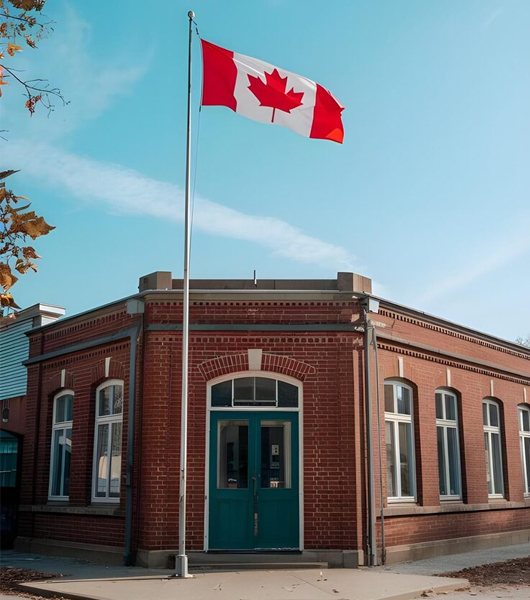NSN helped me understand the Canadian financial system, which seemed so complicated at first. Thanks to their guidance, I rented my first apartment easily and started building my credit confidently. Highly recommend their services!
Educational Center
Your Guide to Canada’s Education System
Investing in education is one of the most meaningful steps you can take toward building a successful life in Canada. Our Educational Center is here to guide you through every stage of the journey—whether it’s enrolling your children in school, exploring colleges and universities, meeting language requirements, or getting your credentials recognized. With clear information and trusted connections, we help you make confident choices and settle into Canada’s education system with ease.
Understanding Canada’s Academic Pathways
How Schools Are Organized
Canada’s school system is designed to make learning accessible and inclusive for every child. Publicly funded K–12 education is available across all provinces and territories, with local school boards managing day-to-day operations. Most children attend their neighborhood school, though some districts also offer specialized programs—such as French immersion or advanced academics—through a separate application process.
In addition to public schools, families may also choose independent or private schools, which follow provincial standards but charge tuition fees.
The school year typically runs from September to June, with regular progress reports, report cards, and parent–teacher meetings to keep families informed.
Learning Pathways and Programs
Students can study in English, French, or French Immersion, depending on the region and family preference. For newcomers, schools often provide dedicated language support programs to help children adapt and succeed in their chosen stream.
Support Systems in Schools
Newcomer families are never alone in navigating the system. Dedicated professionals ensure students feel supported at every stage:
- Settlement Workers in Schools (SWIS): Guide families through registration, school routines, and community resources.
- Language Support Teachers: Help students strengthen their English or French skills while keeping up with academics.
- Guidance and Career Counsellors: Assist with course selection, pathway planning, and future opportunities.
- Special Education Teams: Provide tailored support and accommodations for students with unique learning needs.
Personalized Support for Every Individual
Community Networkings that Matter
World-class Programs with Real Impact
Schooling Options for Children in Canada (and How to Choose)
Finding the right school for your child is one of the most important steps in helping them feel settled and confident in their new home. Canada offers a variety of schooling pathways, each designed to nurture learning, creativity, and growth. Here’s a closer look at what you can expect:
Early Years (Pre-K & Kindergarten)
The early years are all about play, discovery, and curiosity. Kindergarten usually begins around ages 4–5, though the starting age varies by province. Many communities also provide before- and after-school programs along with family centres that make it easier for children and parents to adjust.
Elementary to High School
- Elementary (Grades 1–5/6): Focuses on building strong foundations in reading, writing, math, sciences, arts, and physical education.
- Middle/Junior (Grades 6–8): Transitional years with more subject-specific teachers to prepare students for independence.
- Secondary (Grades 9–12): A credit-based system that guides students toward graduation and future pathways, whether that’s apprenticeships, college, or university.
Diverse Program Choices
Canadian schools celebrate diversity and offer a wide range of learning streams, including:
- French Immersion or Francophone programs
- English as a Second Language (ESL/EAL) support
- Arts, STEM, International Baccalaureate (IB), or Advanced Placement (AP) programs
- Specialist High Skills Majors and co-op/experiential learning opportunities
Factors to Consider When Choosing
Every child’s journey is unique. Practical things to think about include:
- Distance from home and busing options
- Language support and newcomer orientation services
- Extracurricular activities, school culture, and class sizes

Settling Into School Life: A Step-by-Step Guide

Registration Essentials
Be prepared with key documents such as proof of age, address, immigration/study papers (if applicable), immunization records, and past report cards.
Assessments and Placement
Schools may carry out language or math/reading assessments to better understand your child’s needs and recommend the right level for high school courses.
What the First Months Look Like
- A homeroom teacher or vice-principal will often be your main point of contact.
- Communication happens via emails, school apps, or parent portals—with interpretation available when needed.
- Families are introduced to school policies on attendance, conduct, safety, and well-being.
Tips for a Smooth Transition
- Attend parent–teacher meetings (with interpreter support if necessary).
- Encourage reading at home—in any language.
- Help your child explore clubs, teams, and activities to build confidence and friendships.
Language Proficiency: Opening Doors to Learning
For Children
Good news — children do not need to pass a formal language test to enter public schools in Canada. Once enrolled, schools conduct in-class assessments and provide the language support they need to thrive.
For Post-Secondary Studies
Colleges and universities set their own language requirements. Most accept tests like IELTS Academic, TOEFL iBT, CAEL, PTE Academic, or approved pathway programs. Francophone institutions may also accept TEF/TCF or their own assessments.
If you’re close to the requirement, many institutions grant conditional admission and guide you through an academic English or French program first.
Improving Your Language Skills
Newcomers have access to a wide range of support:
- Government-funded settlement language classes
- College ESL/FSL preparation programs
- Conversation circles to practice speaking
- Academic writing and learning centres

Recognition of Foreign Credentials: Turning Experience into Opportunity

Academic Pathway
If you’re applying to a Canadian college or university, your school will review your past studies to determine admission eligibility and potential transfer credits.
Professional Pathway
For regulated professions such as nursing, teaching, or engineering, licensing bodies determine the steps you need to take. These may include:
- Credential assessments (ECA)
- Official transcripts and translations
- Exams, bridging programs, or supervised practice
- Meeting language benchmarks
Helpful Pathways
Canada offers tailored options to help you transition smoothly:
- Bridging programs for internationally trained professionals
- Prior Learning Assessment & Recognition (PLAR) to convert work experience into academic credit
- Micro-credentials to quickly fill specific skill gaps
Post-Secondary Pathways in Canada
Canada offers a wide range of post-secondary options, and the best path depends on your goals, interests, and lifestyle. Whether you dream of building a career, conducting research, or learning a trade, there’s a pathway here for you.
Choosing the Right Path
- Colleges, Institutes & Polytechnics – Hands-on and career-focused. These programs offer diplomas, certificates, applied degrees, and co-ops that prepare you for the workforce quickly.
- Universities – Known for undergraduate and graduate degrees, plus opportunities in research and professional programs (like law, medicine, or engineering).
- Apprenticeships & Trades – Learn by doing. Combine in-class training with paid work experience while gaining practical skills in high-demand fields.
How Applications Work
Most applications are submitted either directly through the school’s portal or through a provincial application centre. Programs can be competitive, so it’s important to check:
- Prerequisites and minimum language requirements
- Special submissions like portfolios or auditions (where needed)
- Application deadlines for programs, scholarships, housing, and financial aid (these may all differ!)
What to Budget For
Studying in Canada involves more than tuition. Plan ahead for:
- Student fees, books, and supplies
- Housing and transit
- Healthcare coverage (if you’re not yet eligible for provincial health plans)


No matter the path you choose, Canadian institutions provide services to help you succeed and feel supported:
- Accessibility and disability services
- Orientation and settlement support for newcomers and international students
- Academic advising, tutoring, and writing help
- Career services, internships, and job fairs
- Mental health counselling and wellness resources
- Family supports like childcare centres and referral programs
Belong and Connect
Discover a Supportive Network Where You Belong
Contact Us
Starting fresh in Canada? We’re here to help.

Whether you’ve just arrived or need support navigating the next steps, reach out today. Let’s build Life together!
-
Call Anytime
+1 (437) 774-8787 -
Send Email
info@nsncanada.ca
Ready to Start Your Journey? Let’s Make It Easier, Together.
Starting fresh in a new place can be challenging, but you don’t have to navigate it by yourself. Whether it’s settling into your community, accessing key services, or finding the right support, we’re here to make the transition smoother and more meaningful.
Contact UsTestimonials
Love from Newcomers in Canada
NSN made my student journey in Canada seamless. From understanding tuition, scholarships, and courses to building my credit, their step-by-step guidance gave me confidence and peace of mind.
Moving to a new country was overwhelming, but NSN helped me find a safe apartment and explained all the paperwork clearly. I finally feel settled and supported in my new home.
Joining a new community is intimidating, but NSN helped me feel connected. Their cultural orientation sessions and newcomer programs made me feel welcomed and confident in my new city.
From healthcare registration to housing and community resources, NSN made settling in Canada smooth and manageable. I feel prepared and supported every step of the way. I’m grateful for their guidance.

